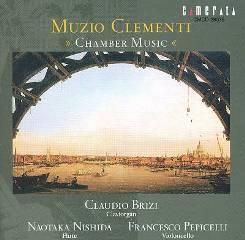Clementi – Chamber Music (Claudio Brizi) [2004]
Clementi – Chamber Music (Claudio Brizi) [2004]

Piano (Harpsichord) Sonata with flute (or violin) accompaniment in G major, Op. 2/3 1 I. Moderato 5:08 2 II. Allegretto 3:05 Piano (Harpsichord) Sonata with flute & cello accompaniment in D major, Op. 21/1 3 I. Allegro di molto 5:30 4 II. Allegretto innocente 3:09 5 III. Finale: Vivace assai 3:50 Piano (Harpsichord) Sonata with flute & cello accompaniment in G major, Op. 21/2 6 I. Allegro con brio 4:37 7 II. Allegretto grazioso 1:23 8 III. Rondeau Allegro 4:10 Piano (Harpsichord) Sonata with flute (or violin) & cello accompaniment in D major, Op. 22/1 9 I. Spiritoso 5:27 10 II. Arietta con varizioni: Allegretto... 2:33 11 II. ...Allegro molto 1:12 Sonata for piano (or harpsichord) & flute in A major, Op. 31 12 II. Introduzione... 2:43 13 I. ...Un poco allegro ma con espressione 5:50 14 II. Spiritoso ma con grazia 6:28 Claudio Brizi - claviorgan Naotaka Nishida - flute Francesco Pepicelli - cello
Fusing two musical instruments into one is an obscure but persistent human impulse. The uneuphoniously named claviorgan might be thought of as the classical counterpart to Junior Brown's "guit-steel" electric guitar-steel guitar combination. It's a small organ with a row of plucked strings similar to those of a harpsichord. Instrument builders made them occasionally for several centuries, but they never really took hold. On this album of short flute-and-piano or flute-cello-and-piano sonatas by Muzio Clementi, a claviorgan is used in place of the piano. The effects are unusual, to say the least.
If you're looking for something to put on at a party that's guaranteed to make even serious classical music obsessives ask what in the world it could possibly be, this release fills the bill. Clementi, a composer whose work was shaped by a distinct pianism that influenced Beethoven, was perhaps an odd choice of medium for the revival of the claviorgan; Bach might have offered equally intriguing but more idiomatic possibilities. The slower sound production of the organ pipes seems to necessitate a slight degree of rubato that doesn't quite mesh with Clementi's musical language. Yet the performers (flutist Naotaka Nishida, cellist Francesco Pepicelli, and Claudio Brizi on the claviorgan) treat these tempo variations consistently, and after a while they begin to seem natural. The claviorgan has a fascinating sound indeed, and at several points, notably where Brizi selects a stop that offers an unexpected contrast with the flute, you may be moved to laugh out loud. That's got to be healthy. The sonatas themselves are full of surprises; check out the variation finale of the Sonata in D major, Op. 22/1, for harmonic moves that don't sound like Haydn, Mozart, or Beethoven -- and for another great example of Brizi's sense of humor. The claviorgan on this Japanese recording is more than just a chindogu novelty (look it up); it's a refreshing trip back into one of classical music's rarely visited alleyways. --- James Manheim, Rovi
download:
uploaded yandex 4shared mega solidfiles zalivalka cloudmailru filecloudio oboom
